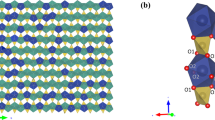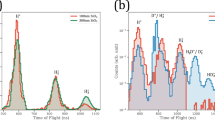Abstract
All superheavy elements (SHEs), with atomic numbers (Z) ≥104, have been artificially synthesized one atom at a time and their chemical properties are largely unknown. Because these heavy nuclei have short lifetimes as well as extremely low production rates, chemical experiments need to be carried out on single atoms and have mostly been limited to adsorption and extraction. We have now investigated the precipitation properties of the SHE Rf (Z = 104). A co-precipitation method with samarium hydroxide had previously established that the co-precipitation behaviour of a range of elements reflected these elements’ tendency to form hydroxide precipitates and/or ammine complex ions. Here we investigated co-precipitation of Rf in basic solutions containing NH3 or NaOH. Comparisons between the behaviour of Rf with that of Zr and Hf (lighter homologues of Rf) and actinide Th (a pseudo-homologue of Rf) showed that Rf does not coordinate strongly with NH3, but forms a hydroxide (co)precipitate that is expected to be Rf(OH)4.

This is a preview of subscription content, access via your institution
Access options
Access Nature and 54 other Nature Portfolio journals
Get Nature+, our best-value online-access subscription
$29.99 / 30 days
cancel any time
Subscribe to this journal
Receive 12 print issues and online access
$259.00 per year
only $21.58 per issue
Buy this article
- Purchase on Springer Link
- Instant access to full article PDF
Prices may be subject to local taxes which are calculated during checkout



Similar content being viewed by others
Data availability
The data that support the findings of this study are included with the article and Supplementary Information. Source data for Figs. 2 and 3 are provided with the paper. Source data are provided with this paper.
References
Schädel, M., Shaughnessy, D. (eds) The Chemistry of Superheavy Elements 2nd edn (Springer, 2014).
Schädel, M. Chemistry of the superheavy elements. Philos. Trans. R. Soc. A 373, 20140191 (2015).
Schwerdtfeger, P., Pašteka, L. F., Punnettt, A. & Bowman, P. O. Relativistic and quantum electrodynamic effects in superheavy elements. Nucl. Phys. A 944, 551–577 (2015).
Indelicato, P., Santos, J. P., Boucard, S. & Desclaux, J. –P. QED and relativistic corrections in superheavy elements. Eur. Phys. J. D 45, 155–170 (2007).
Ball, P. Extreme chemistry: experiments at the edge of the periodic table. Nature 565, 552–555 (2019).
Düllmann, Ch. E. et al. Chemical investigation of hassium (element 108). Nature 418, 859–862 (2002).
Aksenov, N. V. et al. On the volatility of nihonium (Nh, Z = 113). Eur. Phys. J. A 53, 158 (2017).
Strub, E. et al. Fluoride complexation of rutherfordium (Rf, element 104). Radiochim. Acta 88, 265–271 (2000).
Haba, H. et al. Anion-exchange behavior of Rf in HCl and HNO3 solutions. J. Nucl. Radiochem. Sci. 3, 143–146 (2002).
Haba, H. et al. Fluoride complexation of element 104, rutherfordium. J. Am. Chem. Soc. 126, 5219–5224 (2004).
Toyoshima, A. et al. Hexafluoro complex of rutherfordium in mixed HF/HNO3 solutions. Radiochim. Acta 96, 125–134 (2008).
Ishii, Y. et al. Fluorido complex formation of element 104, rutherfordium (Rf). Bull. Chem. Soc. Jpn 84, 903–911 (2011).
Li, Z. et al. Sulfate complexation of element 104, Rf, in H2SO4/HNO3 mixed solution. Radiochim. Acta 100, 157–164 (2012).
Maly, M., Sikkeland, T., Silva, R. & Ghiorso, A. Nobelium: tracer chemistry of the divalent and trivalent ions. Science 160, 1114–1115 (1968).
Choppin, G., Liljenzin, J.–O. & Rydberg, J. Radiochemistry and Nuclear Chemistry 3rd edn (Butterworth–Heinemann, 2002).
Kikunaga, H. et al. Development of a rapid source preparation method for high-resolution α-particle spectrometry. Appl. Radiat. Isot. 67, 539–543 (2009).
Kasamatsu, Y. et al. Coprecipitation experiment with Sm hydroxide using a multitracer produced by nuclear spallation reaction: a tool for chemical studies with superheavy elements. Appl. Radiat. Isot. 118, 105–116 (2016).
Kasamatsu, Y. Development of new methods for aqueous chemistry on element 104, rutherfordium: batch-type solid–liquid extraction and coprecipitation. J. Nucl. Radiochem. Sci. 18, 24–31 (2018).
Kasamatsu, Y. et al. Coprecipitation behaviors of Zr, Hf, and Th with Sm hydroxide for chemical study of element 104, Rf. J. Nucl. Radiochem. Sci. 14, 7–11 (2014).
Düllmann, Ch. E. & Türler, A. 248Cm(22Ne,xn)270−xSg reaction and the decay properties of 265Sg reexamined. Phys. Rev. C 77, 064320 (2008).
Asai, M. et al. Experimental identification of spin-parities and single-particle configurations in 257No and its α-decay daughter 253Fm. Phys. Rev. Lett. 95, 102502 (2005).
Brüchle, W. Confidence intervals for experiments with background and small numbers of events. Radiochim. Acta 91, 71–80 (2003).
Bilinski, H., Branica, M. & Sillen, L. G. Precipitation and hydrolysis of metallic ions. II. Studies on the solubility of zirconium hydroxide in dilute solutions and in 1 M NaClO4. Acta Chem. Scand. 20, 853–861 (1966).
Ueda, J. & Takagi, M. Graphite furnace atomic absorption spectrometric determination of bismuth(iii) after coprecipitation with hafnium hydroxide. Bull. Chem. Soc. Jpn 63, 544–547 (1990).
Sillen, L. G., Martell, A. E. (eds) Stability Constants of Metal–Ion Complexes, Special Publication No 17 (Chemical Society, 1964).
Baes, C. F. Jr. & Mesmer, R. E. The Hydrolysis of Cations (Wiley, 1976).
Shikina, N. D. et al. Hydrolysis and complex formation of Zr and Hf in aqueous solutions of HClO4, HCl, and NaOH in equilibrium with baddeleyite (Zr and Hf)O2(cr) at 250 °C. Russ. J. Chem. A 92, 2159–2164 (2018).
Spence, R. Coprecipitation and adsorption rules. Proc. Soc. Anal. Chem. 9, 264–266 (1972).
Pershina, V., Trubert, D., Le Naour, C. & Krats, J. V. Theoretical predictions of hydrolysis and complex formation of group-4 elements Zr, Hf and Rf in HF and HCl solutions. Radiochim. Acta 90, 869–877 (2002).
Czerwinski, K. R. Studies of Fundamental Properties of Rutherfordium (Element 104) Using Organic Complexing Agents. PhD thesis, Lawrence Berkeley Laboratory (1992).
Bilewicz, A. et al. Chemical studies of rutherfordium (element 104): part I. Thin film ferrocyanide surfaces for the study of the hydrolysis of rutherfordium. Radiochim. Acta 75, 121–126 (1996).
Lide, D. R. (ed.) CRC Handbook of Chemistry and Physics 79th edn (CRC Press, 1998).
Pershina, V. in Relativistic Electronic Structure Theory, Part 2: Applications Vol. 14 (ed. Schwerdtfeger, P.) 1–80 (Elsevier, 2014).
Kasamatsu, Y. et al. Development of an automated batch-type solid–liquid extraction apparatus and extraction of Zr, Hf, and Th by triisooctylamine from HCl solutions for chemistry of element 104, Rf. Radiochim. Acta 103, 513–521 (2015).
Haba, H. et al. Automated rapid α/SF detection system for studying aqueous chemistry of superheavy elements at RIKEN. RIKEN Accel. Prog. Rep. 45, 204 (2012).
Yokokita, T. et al. Observation of the chemical reaction equilibria of element 104, rutherfordium: solid–liquid extraction of Rf, Zr, Hf and Th with Aliquat 336 resin from HCl. Dalton Trans. 45, 18827 (2016).
Acknowledgements
This work was performed at the RI Beam Factory operated by RIKEN Nishina Center and CNS, University of Tokyo. The authors are grateful to the staff members of RIKEN Nishina Center for their excellent beam operation. This work was supported by JSPS KAKENHI grant numbers 24655050 and 16K05815.
Author information
Authors and Affiliations
Contributions
Y. Kasamatsu, H.H., H.K., T. Yokokita and A.S. wrote the main part of the manuscript. K. Toyomura and Y. Kasamatsu mainly conducted the experiments and were responsible for data analysis. H.H., T. Yokokita, Y.S., Y. Komori, J.K., M.H., M.M., A.K., Y.Y. and H.K. contributed to the online experiments and E. W., T. Yoshimura and K.M. contributed to the discussion of results. H.K., K. Takamiya, Y. Kasamatsu, T.O. and T.M. developed the co-precipitation method.
Corresponding author
Ethics declarations
Competing interests
The authors declare no competing interests.
Additional information
Publisher’s note Springer Nature remains neutral with regard to jurisdictional claims in published maps and institutional affiliations.
Supplementary information
Supplementary Information
Supplementary discussions, Fig. 1 and Tables 1 and 2.
Source data
Source Data Fig. 1
Statistical source data for Fig. 2.
Source Data Fig. 2
Statistical source data for Fig. 3.
Rights and permissions
About this article
Cite this article
Kasamatsu, Y., Toyomura, K., Haba, H. et al. Co-precipitation behaviour of single atoms of rutherfordium in basic solutions. Nat. Chem. 13, 226–230 (2021). https://doi.org/10.1038/s41557-020-00634-6
Received:
Accepted:
Published:
Issue Date:
DOI: https://doi.org/10.1038/s41557-020-00634-6
This article is cited by
-
Advanced TEM Characterization for Single-atom Catalysts: from Ex-situ Towards In-situ
Chemical Research in Chinese Universities (2022)
-
Probing precipitation properties
Nature Chemistry (2021)



